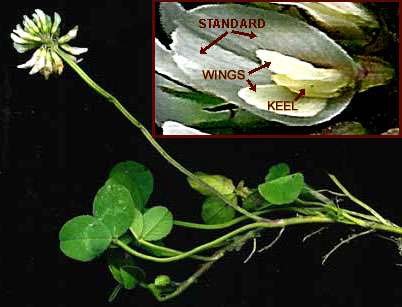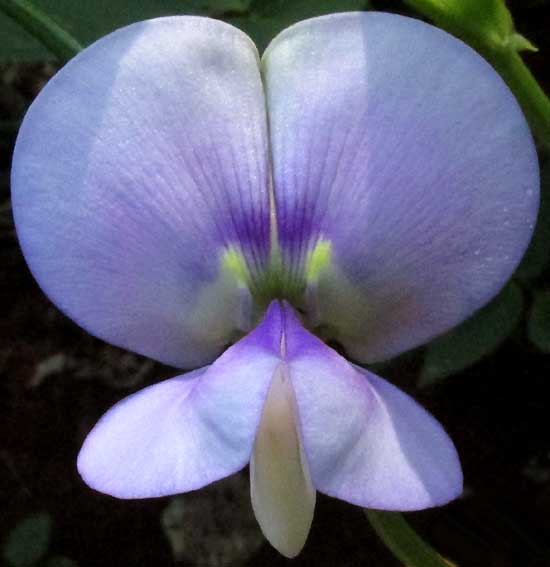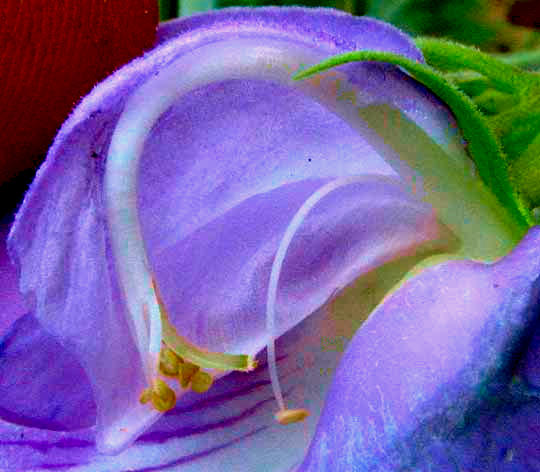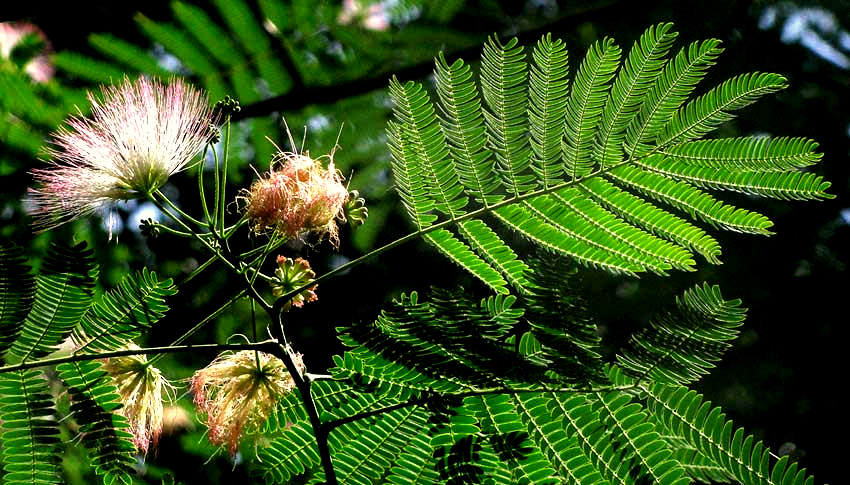 The Bean, Pea or Legume Family (take your pick) is the third-largest of all families of flowering plants. Many garden species and "weeds" belong to the family, so it's one of the most common plant families backyard naturalists are likely to encounter. White Clover, Trifolium repens, shown above, commonly occurs in backyards, field margins, along sidewalks, etc. Other well-known members include garden beans and peas, lupine, vetch, wisteria, and alfalfa, as well as redbud, honeylocust and black-locust trees.
The Bean, Pea or Legume Family (take your pick) is the third-largest of all families of flowering plants. Many garden species and "weeds" belong to the family, so it's one of the most common plant families backyard naturalists are likely to encounter. White Clover, Trifolium repens, shown above, commonly occurs in backyards, field margins, along sidewalks, etc. Other well-known members include garden beans and peas, lupine, vetch, wisteria, and alfalfa, as well as redbud, honeylocust and black-locust trees.
BEAN-FLOWER SYMMETRY

In the above picture of White Clover, the inset at the top, right identifies features typical of most but certainly not all Bean Family flowers. You might practice finding those parts on the very different-looking but structurally similar blossom of the Cowpea, Vigna unguiculata, at the right. The standard or banner is an enlarged petal held above the lower parts, attracting pollinators' attention. The wings are two side petals, and the keel consists of the flower's two lowest petals joined together along their common margin, forming something like a scoop or boat's keel. Flowers with standard, wings and keel like this are said to be papilionaceous. In French, the word for butterfly is papillon, so the word papilionaceous means "butterfly-like."
Note that if you were to cut the blue Cowpea flower down the center, from top to bottom, each blossom half would be a mirror image of the other. Such blossoms are said to display bilateral symmetry, which is very different from the radial symmetry shown by our Standard Blossom, which possesses radial symmetry. In botany, radially symmetrical blossoms are known as "regular" flowers, while bilaterally symmetrical ones are "irregular." Noticing whether a blossom has bilateral or radial symmetry is a big deal in plant identification.

The blossom at the left, of the Butterfly Pea, Centrosema schottii, shows an interesting variation on the basic standard/wings/keel theme just described. Here, the standard, which "should" be expanded above the wings and keel, is twisted around so that it forms a "bed" from which the curved item emerges. That curved item of course consists of the wings and keel wrapped around the stamens and pistil.
INSIDE THE COROLLA

At the right, the flower of another Butterfly Pea species, Centrosema virginianum, has its upside-down keel split open to reveal the stamens within it. The slender, white arch is composed of the filaments of 10 stamens, with 9 of the filaments fused together to form a cylinder surrounding the hidden ovary's style. That cylinder is split along one side, where one stamen separates from the other nine, as clearly seen in the photo. Stamens in such a 9+1 combination are said to be diadelphous, and when you see a flower with diadelphous stamens, think "Bean Family."
THE SUBFAMILIES

Sometimes you see a flower similar to the one at the left that supposedly belongs the Bean Family, though clearly the petals don't fit the standard/wings/keel model, the stamens aren't diadelphous, and maybe there are even fewer obvious stamens than ten. In fact, the flower at the left, belonging to one of many plants known as sennas (it's Senna villosa), is indeed a Bean Family member -- just that it's not a member of the largest, most commonly encountered, currently recognized six subfamilies. Sennas belong to the Caesalpinia Subfamily, not the big "Faboideae," which has no good English name, unless we just designate it the Bean or Pea subfamily, and whose papilionaceous flowers with diadelphous stamens are being described above.
In fact, the Bean Family's whole name/classification business is in a mess, its terms are not standardized, and its taxonomy is a matter of continuing debate. The backyard naturalist should just know that the confusion exists, and not worry too much about "getting the exact taxonomy straight" for each new discovery.
In the old days, texts taught that the Bean Family was divided into only three subfamilies, two of them being the "Faboideae" and Caesalpinia subfamilies mentioned above. The third was the Acacia or Mimosa Subfamily, an example shown below:

That's the Silk Tree, Albizia julibrissina, native to Asia but commonly planted worldwide for its pretty flowers. It's a member of the Mimosa Subfamily. You can see that the flowers' numerous stamens (not just ten or fewer) extend far beyond the tiny corollas (with radial, not bilateral symmetry), which are clustered together in heads. Just looking at the flowers, you wonder what's so "beany" about members of this subfamily. However, when the fruits develop, they're typical legumes of the kind expected in the Bean Family no matter what the flowers look like.
Who said Nature has to be consistent, and group all her creations according to human subdivisions? Maybe the Bean Family teaches us something important about life in general.